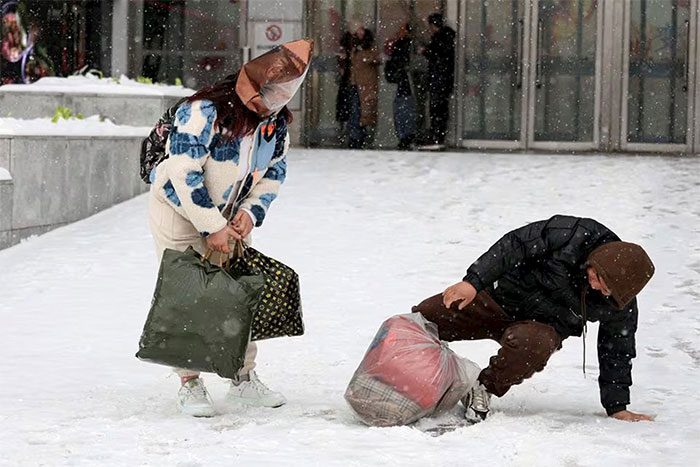The reason for the piercing cold air sweeping into China this month, setting a record for seasonal low temperatures, may stem from the weakening of the polar vortex.
Accompanied by strong winds that prompted the Chinese authorities to issue the highest warning for gusts, a powerful cold air mass surged into the north on December 13. The cold air quickly moved eastward, enveloping the capital, Beijing, in freezing weather, and within a few days, it crossed the Yangtze River, bringing rare snowfall to remote mountainous areas in southern regions like Guangdong.
Severe cold winters are common in China. However, the significantly lower temperatures and the prolonged duration of the current cold spell suggest that there may be a leak in the circular cold air mass surrounding the Arctic, known as the polar vortex, which typically tightly wraps around the Arctic and prevents Arctic air from spilling into lower latitudes.

A man falls on a slope while snow falls in Beijing, China, on December 14, 2023. (Source: Reuters).
The polar vortex is a massive three-dimensional wind system surrounding the North and South Poles during each hemisphere’s winter. These winds operate at altitudes of 16-50 km above the Earth’s surface, in the stratosphere. They blow from west to east at speeds that easily exceed 160 km/h. In the darkness of polar nights, temperatures within the polar vortex can easily drop below minus 79 degrees Celsius.
In recent years, meteorologists have blamed the displacement of the polar vortex, which moves at high speeds from west to east at altitudes of up to 50 km, as the cause of the frigid cold that descends upon North America.
Dr. Shao Sun, a climatologist at the University of California, Irvine, stated: “In the past 30 years, the Arctic Circle has experienced the fastest warming period globally, known as the Arctic Amplification. This warming has led to the weakening of the polar vortex, allowing the cold air inside the vortex to easily move southward, contributing to cold waves.”
The debate remains lively about whether such weakening of the polar vortex will become more common in the future and how directly global warming influences their frequency. However, researchers indicate that global warming leads to more extreme weather phenomena, including unusual cold spells in winter.
Dr. Sun added that severe cold spells do not contradict global warming but instead indicate that the climate system is becoming increasingly unstable and that climate forecasts based on regional averages or monthly averages are no longer accurate.
A recent report from the National Oceanic and Atmospheric Administration (NOAA) indicated that the extent of sea ice continues to decrease and temperatures in the Arctic have risen at least twice as fast as the global temperature since 2000.
According to NOAA, the 12-month period ending in September 2023 marked the sixth warmest year in the Arctic since records began in 1900.
In Norilsk, Russia, the northernmost city in the world with a significant settled population, temperatures are expected to range from minus 10 degrees Celsius to minus 19 degrees Celsius this week, a rise from minus 20 degrees Celsius to minus 39 degrees Celsius from the previous week.
The warmer conditions in Norilsk, located nearly 2,500 km north of the Chinese border, stand in stark contrast to the low temperatures in northern China.
In the city of Datong in Shanxi Province, over 3 million residents faced temperatures as low as minus 33.2 degrees Celsius this week. The city of Baoding in neighboring Hebei Province froze at minus 23.3 degrees Celsius, a new record for this industrial city southwest of Beijing.
Yuan Meng, 27, who lives in the city of Taiyuan, the capital of Shanxi Province, complained: “When I grasp the steering wheel to drive to work in the morning, it feels like I’m holding two giant ice pillars.”
Woo Jin-kyu, an official at the Korea Meteorological Administration in Seoul, warned that it is difficult to assert whether the weather could get colder solely by examining a weakened polar vortex due to climate change. However, it resembles a “temporary congestion”.
Woo stated: “The congestion has formed strongly around Korea as well as Siberia and Mongolia as the airflow from west to east shifts from north to south.”
Chinese forecasters indicated that the unusual cold weather in the country may end around December 22 in the north and December 23 in the central and eastern regions, with temperatures returning to normal by the end of December. Winter weather forecasting in China has become more complicated with the emergence of the El Niño weather phenomenon. According to Dr. Sun, El Niño typically leads to warmer winters in China.
However, Dr. Sun also noted that nationwide changes throughout the winter may not accurately reflect the severity of extreme phenomena and could even mask fluctuations within the season.
The strength of the polar vortex can vary widely during the winter, and these variations can lead to changes in the strength and position of the “river” of air “flowing” in the troposphere beneath the polar vortex. When the jet stream changes, it affects the movement of weather systems, causing different regions around the world to become warmer or colder, or significantly wetter or drier.

















































